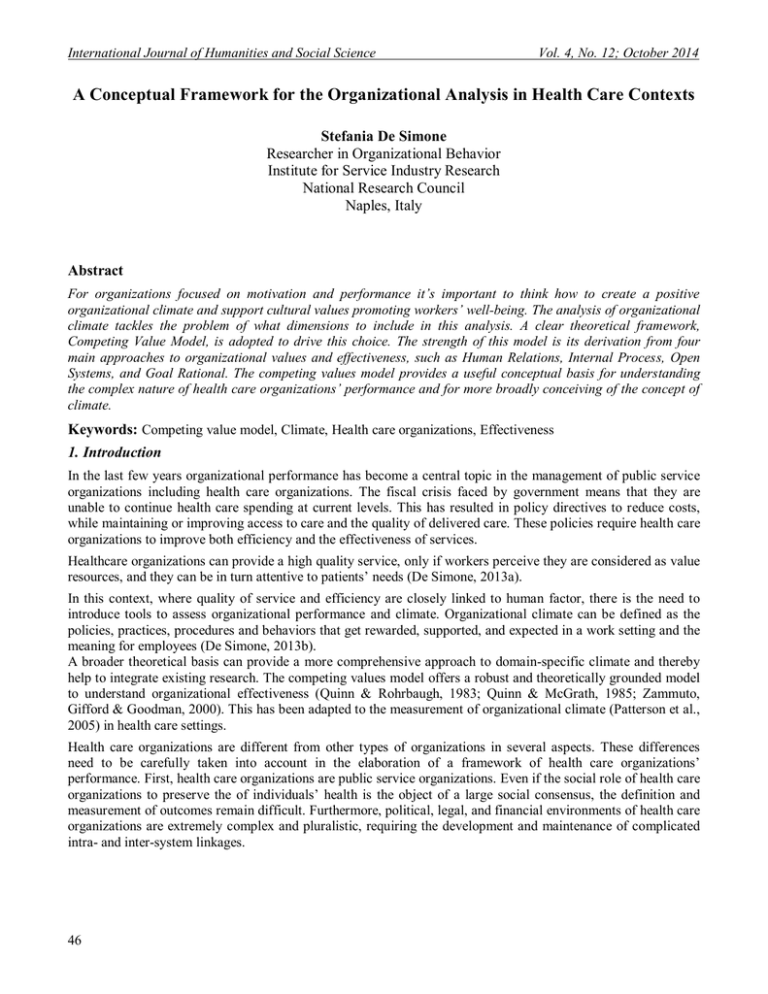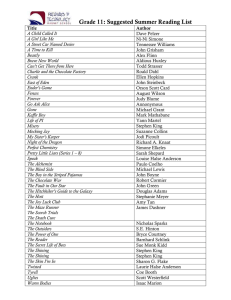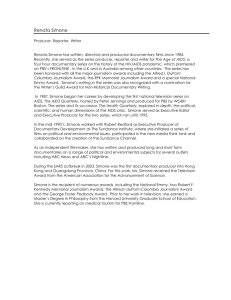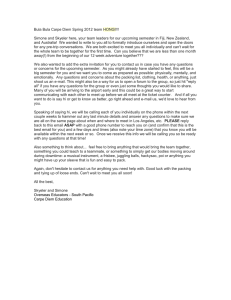Document 10466088
advertisement

International Journal of Humanities and Social Science Vol. 4, No. 12; October 2014 A Conceptual Framework for the Organizational Analysis in Health Care Contexts Stefania De Simone Researcher in Organizational Behavior Institute for Service Industry Research National Research Council Naples, Italy Abstract For organizations focused on motivation and performance it’s important to think how to create a positive organizational climate and support cultural values promoting workers’ well-being. The analysis of organizational climate tackles the problem of what dimensions to include in this analysis. A clear theoretical framework, Competing Value Model, is adopted to drive this choice. The strength of this model is its derivation from four main approaches to organizational values and effectiveness, such as Human Relations, Internal Process, Open Systems, and Goal Rational. The competing values model provides a useful conceptual basis for understanding the complex nature of health care organizations’ performance and for more broadly conceiving of the concept of climate. Keywords: Competing value model, Climate, Health care organizations, Effectiveness 1. Introduction In the last few years organizational performance has become a central topic in the management of public service organizations including health care organizations. The fiscal crisis faced by government means that they are unable to continue health care spending at current levels. This has resulted in policy directives to reduce costs, while maintaining or improving access to care and the quality of delivered care. These policies require health care organizations to improve both efficiency and the effectiveness of services. Healthcare organizations can provide a high quality service, only if workers perceive they are considered as value resources, and they can be in turn attentive to patients’ needs (De Simone, 2013a). In this context, where quality of service and efficiency are closely linked to human factor, there is the need to introduce tools to assess organizational performance and climate. Organizational climate can be defined as the policies, practices, procedures and behaviors that get rewarded, supported, and expected in a work setting and the meaning for employees (De Simone, 2013b). A broader theoretical basis can provide a more comprehensive approach to domain-specific climate and thereby help to integrate existing research. The competing values model offers a robust and theoretically grounded model to understand organizational effectiveness (Quinn & Rohrbaugh, 1983; Quinn & McGrath, 1985; Zammuto, Gifford & Goodman, 2000). This has been adapted to the measurement of organizational climate (Patterson et al., 2005) in health care settings. Health care organizations are different from other types of organizations in several aspects. These differences need to be carefully taken into account in the elaboration of a framework of health care organizations’ performance. First, health care organizations are public service organizations. Even if the social role of health care organizations to preserve the of individuals’ health is the object of a large social consensus, the definition and measurement of outcomes remain difficult. Furthermore, political, legal, and financial environments of health care organizations are extremely complex and pluralistic, requiring the development and maintenance of complicated intra- and inter-system linkages. 46 © Center for Promoting Ideas, USA www.ijhssnet.com 2. A Competing Values Approach to health care organizations The Competing Value Model derives from the major schools of organizational effectiveness studies: The Open Systems Model (external focus and flexible relationships with environment) emphasizes the interaction and adaptation of the organization to its environment, with managers seeking resources and innovating in response to market demands (Shipper & White, 1983). The Rational Goal Model (external focus but with tight control within the organization) reflects a rational economic model of organizational functioning in which the emphasis is upon productivity and goal achievement (Hall, 1980). The Human Relations Model (internal focus and flexibility in relation to the environment) reflects the tradition of the socio-technical (Emery & Trist, 1965) and human relations schools (McGregor, 1960). The emphasis is on well-being, growth, and commitment of the community of workers within an organization. The Internal Process Model (internal focus and tight control within the organization) reflects a Tayloristic concern with formalization and internal control of the system in order to efficiently use resources (Sicotte et al., 1998). The integration of different models in a larger comprehensive framework may help in understanding the complex nature of health care organizations’ performance. This Parsonian perspective of organizational analysis focuses on four functions that every social system (including health care organization) needs to ensure its survival: 1. Objectives attainment (rational goal); 2. Adaptation to its environment to get resources, and to transform itself (open systems); 3. Integration of its internal processes for the production (internal process); 4. Culture and values preservation (human relations) (De Simone, 2011a). When organizations are conceived as Open Systems and emphasis is placed on the relationships between an organization and its environment, one of the key organizational processes becomes the acquisition and maintenance of an adequate supply of resources. The adaptation subsystem mandate is to ensure institutional survival and growth through the exploitation of opportunities and threats existing in the environment. In the short term, the health care organization must be able to attract the resources necessary to maintain core activities, to respond to population needs and social values t, and to attract customers. In the long term, the health care organization must also have the ability to transform itself to adapt to the changing environment (De Simone, 2011a). According to the one of the dominant perspectives on organizations, the Rational Goal Model, an organization exists to accomplish specific objectives (Simon, 1947; Emery & Trist, 1965; Price, 1972). In the health care organization, the goal attainment function refers to the capacity of the organization to make strategic choice to achieve the long-term goals of effectiveness, efficiency, and stakeholder satisfaction. Effectiveness is defined in terms of health outcomes, such as improving the health status of individuals. In the health care context of limited availability of resources, efficiency refers to the imperative to prioritize health outcomes in terms of their cost (De Simone, 2011a). The Human Relations Model derives from an organic or natural view of organizations, which are seen as political arenas where multiple stakeholders and coalitions interact and where emphasis is placed on the satisfaction of stakeholders’ needs and on activities required by the organization to survive (McGregor, 1960). From an external perspective, the health care organization is a designed tool with the ultimate goal of acquiring resources and accomplishing tasks. From an internal perspective, the organization is a socio-technical system influenced by the values and norms of the governing body and the organization staff. This cultural system contributes to organizational performance to the extent that values and norms are reflected in the production structures and processes, to the extent that organizational goals are defined in accordance with these values, and to the extent that mechanisms of adaptation and resource acquisition are aligned with values system. In health care organizations the professional norms on ethics, professional autonomy, and patient dedication are generally perceived as positive values which contribute to the overall performance. Professional norms are internalized by the professionals. Professional values and clinical commitments define and control the organization a san action system. Health care organizations are composed of various groups of professionals, each having their own values and behaviour code. Thus, a climate of collaboration and task-sharing responsibility becomes an important ingredient of performance (De Simone, 2011a). 47 International Journal of Humanities and Social Science Vol. 4, No. 12; October 2014 According to the Internal Process Model, a high performance organization runs smoothly, without undue internal strain (March & Simon, 1958). Stability, predictability, and control are valued, and information management, communication, and optimized decision-making are key processes. Service production, including clinical and support services, is the technical core of the health care organization. The definition of organizational performance is closely linked to the coordination of production factors. The integration of organizational mechanism and the smooth running of operations are key factors in maximizing outputs. The evaluation of health care organizations’ performance in terms of productivity is widespread (De Simone, 2011b). The service production function also includes the quality of care and services delivered, becoming more and more a responsibility not only of the professionals but also of the whole organization. 3. Climate and Effectiveness Outcomes Recent studies on the relationship between organizational performance and climate have showed that a positive work environment can help to improve outcomes, by creating a positive perception of how things are made, reducing work stress and favouring innovations, as a response to environmental and organizational change (Schneider, Ehrhart, & Macey, 2011; Härtel, & Ashkanasy, 2011). In health care contexts, a good organizational climate predicts patient care, efficiency, innovation, patient satisfaction, reducing errors and improving the quality of patient care (West & al., 2002). A broader theoretical basis can provide a more comprehensive approach to domain-specific climate and thereby help to integrate existing research. The competing values model offers a robust and theoretically grounded model to understand organizational effectiveness (Quinn & Rohrbaugh, 1983; Quinn & McGrath, 1985; Zammuto, Gifford & Goodman, 2000). This has been adapted to the measurement of organizational climate (Patterson et al., 2005). According to the Competing Value model, organizational effectiveness criteria can be best understood when organized along fundamental dimensions: flexibility versus control and internal versus external orientation (Patterson et al., 2005). The essential point is that the organizational ideology and culture will shape decisionmaking and action of the organization (Beyer, 1981; Zammuto, Gifford & Goodman, 2000), and consequently will play an important role in the development of its climate. The Competing Value Model provides a framework of values that underlie organizational climate. It calls attention to how opposing values existing in organizations are reflected in their desired ends and in the means to attain them, such as their structural designs and mechanism of coordination and control (Anderson & West, 1998; Ashkanasy, Wilderom & Peterson, 2011). The figure 1 illustrates dimensions of climate commonly referred to the model of organizational climate, which fit into the quadrants. Each quadrant includes climate dimensions associated with the four theoretical approaches to the organizational effectiveness. Each of these will be described briefly (West & Richter, 2011). 3.1 Open Systems: Climate Dimensions The emphasis of the Open Systems Model is on the readiness, change and innovation, where norms and values are associated with growth, resource acquisition, creativity and adaptation (Shipper & White, 1983). Climate dimensions which might reflect this model are as follows. Support for Innovation and Flexibility. Support for innovation is the expectation, approval, and practical support of attempts to introduce new and improved ways of doing in the work environment (West & Richter, 2011). In a climate of innovation support, innovative attempts are rewarded rather than punished, new ideas can be routinely rejected, ignored, or attract verbal and practical support. Such group processes powerfully shape individual and team perceptions of climate and behavior. Reflexivity (Environment, Strategy, and Objectives). Reflexivity involves the team reflecting upon and learning from previous experience and then initiating appropriate change (West, 1996). The reflexivity climate incorporates three key elements: reflection, planning, and adaptation. Reflexivity is a significant predictor of the creativity and team effectiveness. Teams can plan situations, have a better knowledge of their work, and anticipate mistakes. In healthcare units, teams that take time out to reflect on their objectives, strategies, and processes are more effective than those that do not (West & Richter, 2011). In relation to the open systems of the model, a reflexivity climate would encourage a focus on the environment, strategy and organizational objectives. Reflection on internal team processes is more germane to the final quadrant of the model. 48 © Center for Promoting Ideas, USA www.ijhssnet.com 3.2 Rational Goal: Climate Dimensions The emphasis of the Rational Goal Model (external focus and control orientation) is on the pursuit and attainment of well-defined objectives, where norms and values are associated with productivity, efficiency, goal fulfilment, and performance feedback. Climate dimensions which might reflect this model are as follows. Clarification of Objectives. Clarifying and winning commitment to goals are likely to increase team member motivation and organizational effectiveness. Clarity of and commitment to shared team objectives facilitate integrated knowledge and skills, and the development of new ideas. In a study of health care teams, clarity of and commitment to team goals are associated to high levels of team innovation and productivity (Borrill & al., 2000). Emphasis on Quality and Excellence. A perception of commitment of organizational members to high quality work and excellence is an important climate element. Research evidence from studies of health care teams shows that a commitment to high quality patient care is likely to create a strong sense of task orientation, to encourage constructive controversy, to improve patient care, and to influence organizational innovation (Borrill & al. 2004). 3.3 Human Relations: Climate Dimensions The Human Relations Model (internal focus, flexible orientations) has norms and values associated with belonging, trust, and cohesion, achieved through means such as training and human resource development. Coordination and control are accomplished through empowerment and partecipation (Spreitzer, 1995). Interpersonal relations are supportive, cooperative, and trusting in nature. Climate dimensions representing this quadrant are as follows: Autonomy. It refers to designing jobs in ways which give employees wide scope to enact work (Klein, 1991). Autonomy is also considered as a key structural characteristic of teams. When team members perceive high levels of autonomy, they are more likely to believe they have the decision-making autority to determine their own course of action that can heighten an overall sense of determination, internal motivation, and learning (Spreitzer, 1995). Partecipation. It refers to workers involvement on decision-making process. Participation foster integration and commitment, and is linked to productivity and innovation (Locke, 1991). Perceived participation in decision making means a high level of interaction among team members, better quality of decisions, and less resistance to change. Studies of health care teams support the proposition that team members who participate in decision making tend to have influence over the change process and to invest in the out come of those decisions (Borrill & al, 2000). Team Leader Support. The leader brings task expertise, abilities,, and attitudes to the team influencing the group climate and norms (Hackman, 2002). Perceptions of leader style and support are an important element of team climate. Perceptions of supportive leadership enable organizational members to do their work successfully. Team Member Trust, Safety, and Support. Trust, defined as the willingness to be vulnerable to others, fosters cooperating working within teams (Lawrence & Lorsch, 1967). Trust also engenders the willingness to engage in risk-taking behaviors, explore new ventures, and take actions that both preserve team integrity and improve performance. Trust can be developed through shared norms that support cooperative actions, equal contribution, and a clear knowledge of members’ competencies and intentions. Psychological safety is defined as “feeling able to show and employ one’s self without fear of negative consequences to self-image, status, or career” (Kahn, 1990, p. 708). Perceptions of psychological safety tend to be shared among organizational members who discuss of their work experiences. Team psychological safety facilitate team working, by fostering an environment in which team members feel confident to be themselves and speak openly without fear of being rejected, punished, or embarrassed by the team (Edmondson & Roloff, 2009). Support refers to “positive social interactions” among organizational members “helping each other” which enhance organizational effectiveness (Campion, Medsker & Higgs, 1993). Perceptions of supportive coworkers relationships contribute to organizational performance, learning (Bishop, Scott & Burroughs, 2000), to job stress reduction (Fenlason & Beehr, 1994), and to job satisfaction (Griffin, Patterson & West, 2001). Conflict. Recent research on contingency models explore the conditions under which climate of (task and relationship) conflict have different effects on work-team effectiveness, including team tasks, conflict norms, and conflict management strategies (Simons & Peterson, 2000). 49 International Journal of Humanities and Social Science Vol. 4, No. 12; October 2014 A climate of constructive (task-related) controversy, characterizing by full exploration of opposing opinions and by emphasis on mutually beneficial goals, improves the quality of decision making and creativity. 3.4 Internal Process: Climate Dimensions In the Internal Process Model (internal focus, control orientation) the emphasis is on stability, where the effects of environmental uncertainty are ignored or minimized. Coordination and control are achieved by adherence to formal rules and procedures. The Internal Process Model represents the classic bureaucracy. Scales which reflect this model are as follows. Formalization. Formalization concerns with formal rules and procedures governing organizational functioning (Pugh & al., 1968; Hall, 1991). The extent to which organizational members perceive a climate of formalization can influence organizational performance. Indications of formalization affecting the behavior of team members and their freedom of action include regular meetings at predictable intervals of duration, and formal allocation of roles, and require reporting arrangements. Such formalization can be a significant support for achievement of productivity and innovation in some circumstances (when the task is well defined) and a detriment in others, when the environment is highly complex and dynamic, requiring quick adjustments. Meeting Climate. A final climate variable in the internal process quadrant is the meeting climate. Meetings are vital in the lives of teams, and how they are conducted by the team can influence team members’ perceptions of the global climate. The meeting climate may typically vary along two key dimensions in any teams: arousal and affect (West & Richter, 2011). Low arousal is associated with long meetings, which members struggle to engage with. High arousal meetings are busy, dynamic, and attentive. Affect can be positive or negative, with feelings of support and engagement versus feeling of anger or threat. There may be high positive meeting climates that induce high arousal and positive feelings of excitement, pride, humour, and engagement; high negative meetings in which there are strong negative feelings of anger or anxiety; low positive meetings in which members are relaxed, easygoing, and happy; and low negative meetings in which members feel bored,, or sad, and disengaged during meetings. Reflectivity (Internal Processes). Reflectivity is a salient climate dimension referring to the perception of a reflectplan-action orientation to internal team processes such as leadership, communication, decision making, problem solving, and task allocation. The Competing Values model provides a useful conceptual basis for more broadly conceiving of the concept of climate. So far, climate has been treated as simply being the aggregate of organizational members’ perceptions. Individual-level constructs (psychological climate) combine through social interaction processes to emerge as unit or organizational level phenomena (work climate). References Anderson, N. R., & West, M. A. (1998). Measuring climate for work group innovation: Development and validation of the team climate inventory. Journal of Organizational Behaviour, 19, 235-258. Ashkanasy, N. M., Wilderom, C. P. M., & Peterson, M. F. (Eds.). (2011). The Handbook of Organizational Culture and Climate. Thousand Oaks: Sage. Beyer, J. M. (1981). Ideologies, values, and decision making in organizations. In P. C. Nystrom, & W. H. Starbuck (Eds.), Handbook of organizational design (Vol. 2, pp. 166-202). New York: Oxford University Press. Bishop, J. W., Scott, K. D., & Burroughs, S. M. (2000). Support, commitment, and employee outcomes in a team environment. Journal of Management, 26(6), 1113-1132. Borrill, C. S., Carletta, J., Carter, A. J., Dawson, J., Garrod, S., Rees, A., Et Al. (2000). The effectiveness of health care teams in the National Health Service. Birmingham: Aston Centre for Health Service Organization Research. Borrill, C. S., West, M. A., Dawson, J. F., & Scully, J. W. (2004). The relationship between staff satisfaction and patient satisfaction: Report to the Department of Health. Birmingham: Aston Business School. Campion, M. A., Medsker, G. J., & Higgs, C. A. (1993). Relations between work group characteristics and effectiveness: Implications for designing effective work groups. Personnel Psychology, 46(4), 823-850. De Simone, S. (2011a). Logiche istituzionali e performance nelle organizzazioni sanitarie. In M. Franco, & S. De Simone, Organizzazioni sanitarie: dal design al management (pp. 1-32). Milano: McGraw-Hill. 50 © Center for Promoting Ideas, USA www.ijhssnet.com De Simone, S. (2011b). Cambiamento nelle organizzazioni ospedaliere: meccanismi strutturali e culturali. In M. Franco, & S. De Simone (Eds.), Organizzazioni sanitarie: dal design al management (pp. 229-258). Milano: McGraw-Hill. De Simone, S. (2013a). Clima organizzativo come percezione del work environment. In M. Franco, & S. De Simone (Eds.), Il comportamento organizzativo nelle strutture sanitarie: relazioni interpersonali e valorizzazione delle persone (pp. 33-58). Milano: McGraw-Hill. De Simone, S. (2013b). Organizational climate and organizational behaviour. XIV Workshop of Organizational Behavior of Professor and Researchers, Organizing in turbulent times: the challenges ahead, May 30-31, University of Rome Sapienza. Edmondson, A. C., & Roloff, K. S. (2009). Overcoming barriers to collaboration: Psychological safety and learning in diverse teams. In E. Salas, G. F. Goodwin, & C. S. Burke (Eds.), Team effectiveness in complex organisations. Cross-disciplinary perspectives and approaches (pp. 183-208). London: Routledge. Emery, F. E., & Trist, E. L. (1965). The causal texture of organizational environments. Human Relations, 18, 2132. Fenlason, K. J., & Beehr, T. A. (1994). Social support and occupational stress: Effects of talking to others. Journal of Organizational Behavior, 15, 157-175. Griffin, M. A, Patterson, M. G, & West, M. A. (2001). Job satisfaction and team work: The role of supervisor support. Journal of Organizational Behavior, 22, 537-550. Hackman, J. R. (2002). Leading teams: Setting the stage for great performances. Harvard: Harvard Business School. Hall, R. H. (1980). Effectiveness theory and organizational effectiveness. Journal of Applied Behavioral Science, 16, 536-545. Hall, R. H. (1991). Organizations: Structures, processes and outcomes. Englewood Cliffs: Prentice - Hall. Härtel, C. E. J., & Ashkanasy, N. M. (2011). Healthy Human Cultures as Positive Work Environments. In N. M. Ashkanasy, C. P. M. Wilderom, & M. F. Peterson (Eds.), The Handbook of Organizational Culture and Climate (2nd ed., pp. 85-100). Thousand Oaks: Sage. Kahn, W. A. (1990). Psychological conditions of personal engagement and disengagement at work. Academy of Management Journal, 33, 692-724. Klein, J. A. (1991). A reexamination of autonomy in light of new manufacturing processes. Human Relations, 44, 21-38. Lawrence, P., & Lorsch, J. (1967). Differentiation and Integration in Complex Organizations. Administrative Science Quarterly, 12, 1-30. Locke, E. (1991). The motivation sequence, the motivation hub, and the motivation core. Organizational Behavior and Human Decision Making Processes, 50, 288-299. March, J., & Simon, H. A. (1958). Organizations. New York: Wiley. McGregor, D. (1960). The Human side of enterprise. New York: McGraw-Hill. Patterson, M. G., West, M. A., Shackleton, V. J., Dawson, J. F., Lawthom, R., Maitlis, S., Et Al. (2005). Validating the organizational climate measure: Links to managerial practices, productivity and innovation. Journal of Organizational Behavior, 26(4), 379-408. Price, J. L. (1972). The study of organizational effectiveness. The Sociological Quarterly, 13(1), 3-15. Pugh, D. S., Hickson, D. J., Hinings, C. R., & Turner, C. (1968). Dimensions of organizational structure. Administrative Science Quaterly, 13, 65-91. Quinn, R. E., & McGrath, M. R. (1985). The transformation of organizational cultures: A competing values perspective. In P. J. Frost, L. F. Moore, M. L. Louis, C. C. Lundberg, & J. Martin (Eds.), Organizational culture (pp. 314-334). London: Sage. Quinn, R. E., & Rohrbaugh, J. (1983). A spatial model of effectiveness criteria: Towards a competing values approach to organizational analysis. Management Science, 29(3), 363-377. Schneider, B., Ehrhart, M. G., & Macey, W. H. (2011). Organizational Climate Research. Achievements and the Road Ahead. In N. M. Ashkanasy, C. P. M. Wilderom, & M. F. Peterson (Eds.), The Handbook of Organizational Culture and Climate (2nd ed., pp. 29-49). Thousand Oaks: Sage. Shipper, F., & White, C. S. (1983). Linking organizational effectiveness and environmental change. Long Range Planning, 16(3), 99-106. 51 International Journal of Humanities and Social Science Vol. 4, No. 12; October 2014 Sicotte, C., Champagne, F., Contandriopoulos, A. P., Barnsley, J., Beland, F., Leggat, S. G., Et Al. (1998). A conceptual framework for the analysis of health care organizations’ performance. Health Services Management Research, 11, 24-48. Simon, H. (1947). Administrative Behavior. New York: MacMillan. Simons, T. L., & Peterson, R. S. (2000). Task conflict and relationship conflict in top management teams: The pivotal role of intragroup trust. Journal of Applied Psychology, 85, 102-112. Spreitzer, G. M. (1995). Psychological empowerment in the workplace: Dimensions, measurement, and validation. Academy of Management Journal, 38, 1442-1465. West, M. A. (1996). Reflexivity and work group effectiveness: A conceptual integration. In M. A. West (Ed.), Handbook of work group psychology (pp. 555-579). Chichester: Wiley. West, M. A., Borrill, C. S., Dawson, J., Shapiro, D., Rees, A., Richards, A., Et Al. (2002). Team working and effectiveness in health care. Birmingham: Aston University. West, M. A., & Richter, A. W. (2011). Team Climate and Effectiveness Outcomes. In N. M. Ashkanasy, C. P. M. Wilderom, & M. F. Peterson (Eds.), The Handbook of Organizational Culture and Climate (2nd ed., pp. 248-270). Thousand Oaks: Sage. Zammuto, R. F., Gifford, B., & Goodman, E. (2000). Managerial ideologies, organizational culture and the outcomes of innovation: A competing values perspective. In N. M. Ashkanasy, C. P. M. Wilderom, & M. F. Peterson (Eds.), Handbook of organizational culture and climate (pp. 261-278). Thousand Oaks: Sage. Figure 1: Competing Value Model: Climate Dimensions 52






